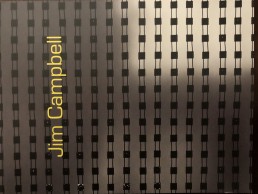Jim Campbell: In the Repose of Memory catalogue
Perfect bound book. Full color printing, 2010
The Eleanor D. Wilson Museum at Hollins University and Roanoke College Galleries are pleased to announce the joint exhibition Jim Campbell: In the Repose of Memory. With degrees in both Mathematics and Engineering from MIT, Campbell makes highly innovative works that have set the standards for art created with technology for more than twenty years. His custom made electronic devices focus on an exploration of how we process and translate memory ¬– both personal and collective. With his roots in technology development for systems that store information, his work enables the viewer to be an observer and a participant. “In the Repose of Memory,” on view at both spaces serves as a progressive retrospective for the artist with a focus on his signature works from the past two decades to the present.
At Roanoke College Olin Hall Galleries, his series “Memory Works” and “Illuminated Averages” among others are on view; while at the Eleanor D. Wilson Museum, his most recent endeavors are displayed. Underscoring a majority of his artistic behaviors is Campbell’s acute interest in Heisenberg’s Uncertainty Principle from Quantum Physics, which hypothesizes that the function or “act” of observation has a direct impact on what is being observed. The artist states “the more you want to see the less you see.” In the exhibited work “Home Movie 1040,” 2008, the viewer encounters a complexly strung daisy chain of 1040 flickering LED (light-emitting diodes) hung vertically from a central horizontal support. Instead of flickering out en route to us, the image is directed toward the wall, denigrated to the barest possible nascent image. Campbell comments, “I wanted the viewer to look through the display device to see the image. More than look through it- to have the display device obscure the image in an uncontrived way.” His “home movie” is created from hundreds of house of culled found film archives honed from garage sales, eBay and other means. Although fractured in appearance, our eyes coalesce the flickering image as familial memories: faces and other aspects of humanity appear and disappear. Campbell states, “By taking away the details, they become more of a reflection of the viewer’s past, a fuzzy memory.” In essence, the work gives us a visual espionage “fix.” Campbell allows us to partially view others selected recollections thereby creating a sensory feeling of poignant nostalgia. We fill in the gaps of recycled home memoirs and transfer it to our subjective memories.
Campbell’s work bridges the gap between technical and implied: seeing versus understanding. His facile handling of memory translates into clever devices that allow us to be purveyors of the recent past.
